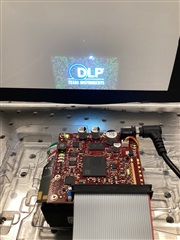Other Parts Discussed in Thread: DLPC3436, DLPA2005
Hello,
I own two DLPDLCR230NPEVM modules and encounter different booting problems with both of them. Both projectors used to work at one time but now are not booting anymore.
- First device:
For the first one I am not really sure what I did wrong. When booting with and without the Raspberry Pi 4B the projector does not display anything and all LEDs (D_HOST_IRQ, D_DONE and D_INIT_B) are illuminated constantly. I tried to re image the flash controller and the fpga but both did not work, the provided python script got an error and was not able to erase the old data. - Second device:
The second one worked fine this morning and I was testing some scripts to switch off the beamer via the GPIO Pin 26. At some point when switching the beamer on, it did not boot correctly and now it displays only the initial "DLP Texas Instruments" logo without the rainbow pattern. Furthermore only the D_INIT_B LED is blinking. I also tried to re image the flash controller and the fpga and here it worked but did not solve the booting problem. I used the dlpc3436_controller_firmware_7.3.14.img and dlpc3436_fpga_firmware_1.1.bin files to re image. But I am not sure if this is the problem because the beamer worked just fine before.
Sometimes it displays strangely colored images like this one:
Thank you in advance
Lukas

